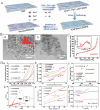Recent Progress on Layered Double Hydroxides and Their Derivatives for Electrocatalytic Water Splitting
- PMID: 30128233
- PMCID: PMC6096997
- DOI: 10.1002/advs.201800064
Recent Progress on Layered Double Hydroxides and Their Derivatives for Electrocatalytic Water Splitting
Abstract
Layered double hydroxide (LDH)-based materials have attracted widespread attention in various applications due to their unique layered structure with high specific surface area and unique electron distribution, resulting in a good electrocatalytic performance. Moreover, the existence of multiple metal cations invests a flexible tunability in the host layers; the unique intercalation characteristics lead to flexible ion exchange and exfoliation. Thus, their electrocatalytic performance can be tuned by regulating the morphology, composition, intercalation ion, and exfoliation. However, the poor conductivity limits their electrocatalytic performance, which therefore has motivated researchers to combine them with conductive materials to improve their electrocatalytic performance. Another factor hampering their electrocatalytic activity is their large lateral size and the bulk thickness of LDHs. Introducing defects and tuning electronic structure in LDH-based materials are considered to be effective strategies to increase the number of active sites and enhance their intrinsic activity. Given the unique advantages of LDH-based materials, their derivatives have been also used as advanced electrocatalysts for water splitting. Here, recent progress on LDHs and their derivatives as advanced electrocatalysts for water splitting is summarized, current strategies for their designing are proposed, and significant challenges and perspectives of LDHs are discussed.
Keywords: electrocatalysts; hydrogen evolution reaction; layered double hydroxides; oxygen evolution reaction; water splitting.
Figures














References
-
- Turner J. A., Science 2004, 305, 972. - PubMed
-
- Seh Z. W., Kibsgaard J., Dickens C. F., Chorkendorff I., Nørskov J. K., Jaramillo T. F., Science 2017, 345, 1593. - PubMed
-
- Chu S., Majumdar A., Nature 2012, 488, 294. - PubMed
-
- Jiao Y., Zheng Y., Jaroniec M., Qiao S. Z., Chem. Soc. Rev 2015, 44, 2060. - PubMed
Publication types
LinkOut - more resources
Full Text Sources
Other Literature Sources
